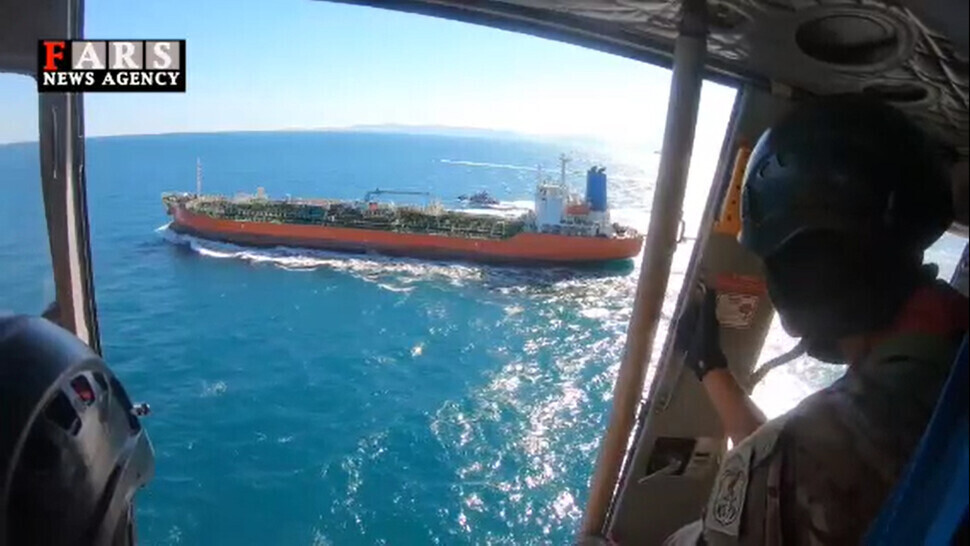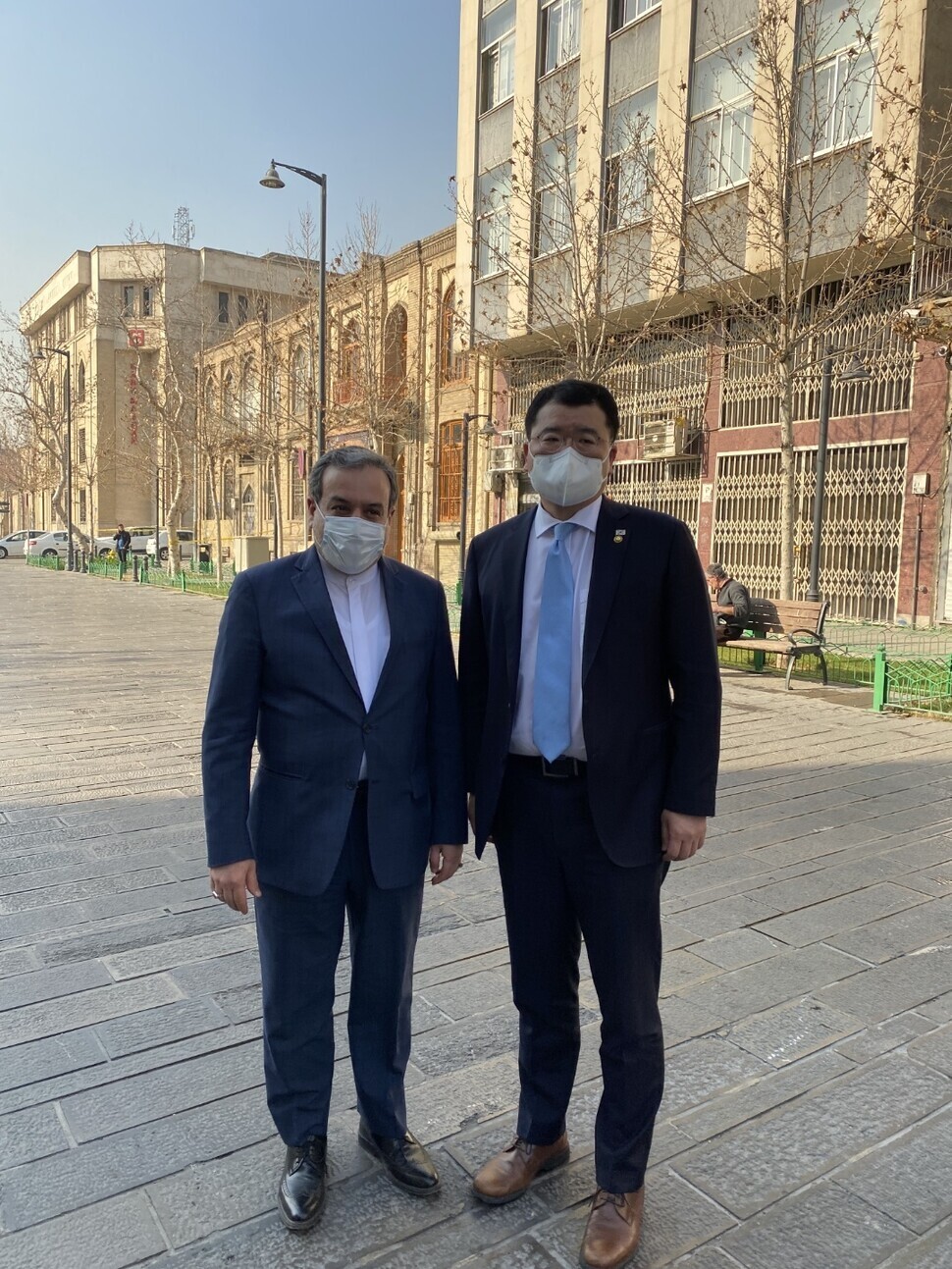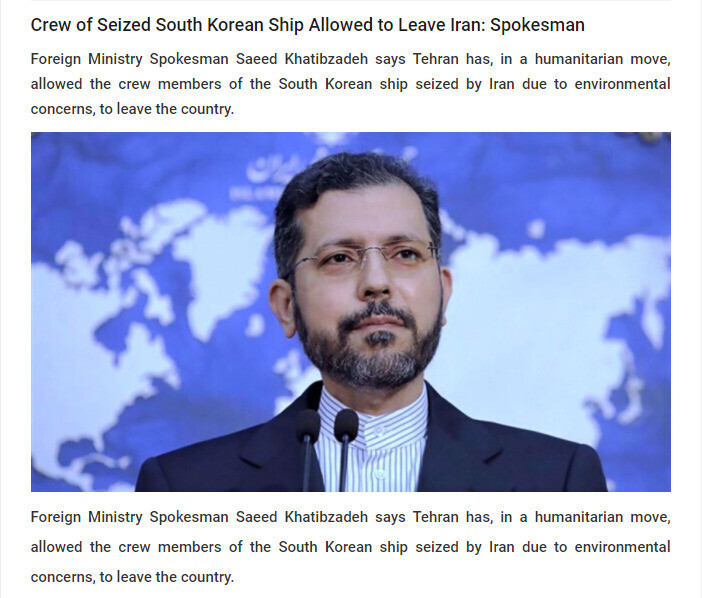hankyoreh
Links to other country sites 다른 나라 사이트 링크
[News analysis] Why did Iran decide to release S. Korean crew members?

Iran’s seemingly abrupt decision to release crew members from a South Korean tanker one month after their Jan. 4 detention for “polluting the Persian Gulf environment” is raising questions about the motivations behind its move.
The release could be seen as having come far earlier than expected in light of Iran’s typically harsh diplomatic approach, which has taken shape amid confrontations with the US and bitter enemy Israel, as well as rival Saudi Arabia.
To begin with, the abrupt release appeared to be based on a preemptive decision by Tehran. A note of tension could be sensed in a press release shared by South Korea’s Ministry of Foreign Affairs (MOFA) around 10 pm on Feb. 2.
The release explained that South Korean First Vice Minister of Foreign Affairs Choi Jong-kun, who is overseeing negotiations with Iran, had a nearly 30-minute telephone conversation with Iranian Deputy Foreign Minister Abbas Araqchi at 6:50 pm that day “for the swift release of South Korean national crew members and other crew members from detention.”
It went on to say Araqchi had “informed” the ministry of the “decision to first release the remaining crew members besides the captain from detention.”
Rather than immediately issuing a press release after the telephone call, MOFA waited for a few hours — as it could not be 100% sure Iran would actually make the decision to release the crew members.
MOFA eventually distributed its press release around 10 pm on Feb. 2, after the decision had been reported by Reuters and made official by spokesperson Saeed Khatibzadeh on the Iranian Foreign Ministry homepage. In effect, it took a “better safe than sorry” approach.

So why did Iran make the decision it did?
The initial answers can be found in the official record. Explaining the reasons for the Iranian government’s decision in a Feb. 2 statement, Khatibzadeh said, “Following the South Korean government’s request and through the good offices of the respected [Iranian] Judiciary in accordance with judicial regulations, crew members of the South Korean vessel seized on charges of polluting the environment in the Persian Gulf have been authorized to leave the country in a humanitarian move by the Islamic Republic of Iran.”
The same statement also said the “necessity of freeing up Iran’s assets in South Korea was emphasized” in the conversation between Choi and Araqchi — a reference to US$7 billion in Iranian assets currently frozen in South Korea.
“The two sides also discussed effective mechanisms to utilize these financial resources. The Korean side also said Seoul is determined to make utmost efforts to release the frozen assets as soon as possible,” the statement continued.
In its own press release, MOFA said that Choi had “explained to Iran that our government is working quickly on the things we are capable of resolving on our own, and that we plan to pursue transparent discussions with the US on matters that require US agreement.”
Taken together, the statements suggest Iran made the preemptive decision to release the crew members out of consideration for its relationship with South Korea — traditionally considered a friend among countries in East Asia — in a situation where a “complete” resolution of the frozen funds issue was not an option. MOFA’s swift response to the detention appears to have had some success in softening Tehran’s stance.

Further answers lie in what the official statements didn’t mention.
The reason Iran’s detention of the South Korean tanker has drawn such global attention has to do with its particular timing. Specifically, it happened just before the inauguration of a new US administration under President Joe Biden, who had declared plans to return to the Iran nuclear deal unceremoniously cast aside by his predecessor Donald Trump.
Jan. 3, the day before the tanker’s seizure, marked the one-year anniversary of the US’ drone strike assassination of Qasem Soleimani, commander of the Quds Force in Iran’s Islamic Revolutionary Guard Corps (IRGC) and a figure venerated as a “hero” in Iran.
On Jan. 4, the same day that the vessel was detained, Iran moved to resume production of 20% enriched uranium, ignoring restrictions in the nuclear deal. (Weapons-grade uranium is enriched to over 90%.)
As Iran recalibrated its relationship with the US, the IRGC and other hard-liners appeared to be on the ascendancy. The IRGC was also responsible for detaining the South Korean tanker.
Since then, however, Iran’s approach has been more circumspect. Instead of carrying out more provocations against the US and other countries, it seems to be proceeding more realistically in its hopes of resurrecting the nuclear deal.
In a Feb. 1 interview with CNN, Iranian Foreign Minister Javad Zarif said Iran was ready for a new relationship with the US, but stressed that the US “has a limited window of opportunity.”
The European Union, which had been critical of the Trump administration’s scrapping of the nuclear deal, also stepped in, announcing on Feb. 2 that it could mediate the US and Iran’s return to the agreement.
After a heated debate in Iran over its future diplomatic course and what sort of relationship to pursue with the Biden administration, the moderates appear to have won out.
But Zarif also warned that the time available to the US was “not unlimited,” suggesting Tehran could return to its hardline approach if the US doesn’t hurry to respond.
Given the breathless pace of developments surrounding Iran’s international situation, the decision to release the crew members is very likely to have been part of the bigger picture of improving relations with Washington.
Ever since the tanker’s detention, the Iranian Foreign Ministry — which could be classified as moderate — has maintained that it reflected “technical views concerning marine pollution” and was unrelated to the frozen funds. It is that official position from the ministry that made the crew members’ early release possible.
In the final analysis, the major diplomatic achievement could be credited both to Iran’s strategic decision to pursue the rational foreign policy approach of returning to the nuclear deal, and to the efforts made by the South Korean government since the detention.
By Gil Yun-hyung, staff reporter
Please direct comments or questions to [english@hani.co.kr]

Editorial・opinion
![[Editorial] Intensifying US-China rivalry means Seoul must address uncertainty with Beijing sooner than later [Editorial] Intensifying US-China rivalry means Seoul must address uncertainty with Beijing sooner than later](https://flexible.img.hani.co.kr/flexible/normal/500/300/imgdb/original/2024/0517/8117159322045222.jpg) [Editorial] Intensifying US-China rivalry means Seoul must address uncertainty with Beijing sooner than later
[Editorial] Intensifying US-China rivalry means Seoul must address uncertainty with Beijing sooner than later![[Column] When ‘fairness’ means hate and violence [Column] When ‘fairness’ means hate and violence](https://flexible.img.hani.co.kr/flexible/normal/500/300/imgdb/original/2024/0516/7417158465908824.jpg) [Column] When ‘fairness’ means hate and violence
[Column] When ‘fairness’ means hate and violence- [Editorial] Yoon must stop abusing authority to shield himself from investigation
- [Column] US troop withdrawal from Korea could be the Acheson Line all over
- [Column] How to win back readers who’ve turned to YouTube for news
- [Column] Welcome to the president’s pity party
- [Editorial] Korea must respond firmly to Japan’s attempt to usurp Line
- [Editorial] Transfers of prosecutors investigating Korea’s first lady send chilling message
- [Column] Will Seoul’s ties with Moscow really recover on their own?
- [Column] Samsung’s ‘lost decade’ and Lee Jae-yong’s mismatched chopsticks
Most viewed articles
- 1For new generation of Chinese artists, discontent is disobedience
- 2[Editorial] Transfers of prosecutors investigating Korea’s first lady send chilling message
- 3[Column] US troop withdrawal from Korea could be the Acheson Line all over
- 4[Column] When ‘fairness’ means hate and violence
- 5Xi, Putin ‘oppose acts of military intimidation’ against N. Korea by US in joint statement
- 6[Exclusive] Unearthed memo suggests Gwangju Uprising missing may have been cremated
- 7China calls US tariffs ‘madness,’ warns of full-on trade conflict
- 8[Editorial] Intensifying US-China rivalry means Seoul must address uncertainty with Beijing sooner t
- 9S. Korea “monitoring developments” after report of secret Chinese police station in Seoul
- 10For Korea’s Justice Ministry, no place is sacred from immigration raids